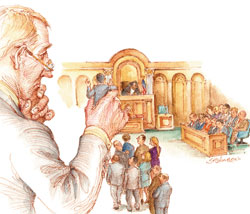McElhaney: Think of Yourself as the First Witness the Jury Will Hear in Your Case

Illustration by John Schmelzer
Andy Lundquist came into the Brief Bag looking for Angus. “I’m in serious need of help,” he said. “What’s the problem?” said Angus. “My first real trial is coming up next week,” said Andy. “I thought I had a handle on everything until I started working on the order in which I’m going to call people to the stand. I know witness order is supposed to be important, but I don’t have any idea where to start.”
“Piece of cake,” said Myra Hebert. “No matter which side you’re on, start strong and end strong. Put your weak witnesses in the middle. Am I right, or what?”
“You’re wrong,” said Flash Magruder, the plaintiffs lawyer. “The order of your issues is more important than the order of your witnesses. If you’re the plaintiff, start with the injury, then go to liability. That way, sympathy will pull the jury over any weak spots in your case concerning liability.”
“I’ve heard those ideas before,” said Andy. “But I still don’t know what to do. I mean, it seems like there’s got to be more to it than that.”
“You’re right,” said Angus. “There is more to it than that. Witness order is important. So is the order of issues, as well as the strengths and weaknesses of both sides of the case. There are so many interrelated factors that bear on the order in which you try a case that there is almost never one perfect way to do it.
“But there are principles that will take a lot of the difficulty out of organizing your trial and settling on the order of your witnesses.”
Angus was just getting started. Here are my notes from what he said:
Click to continue reading “The Lineup” in the March issue of the ABA Journal.



